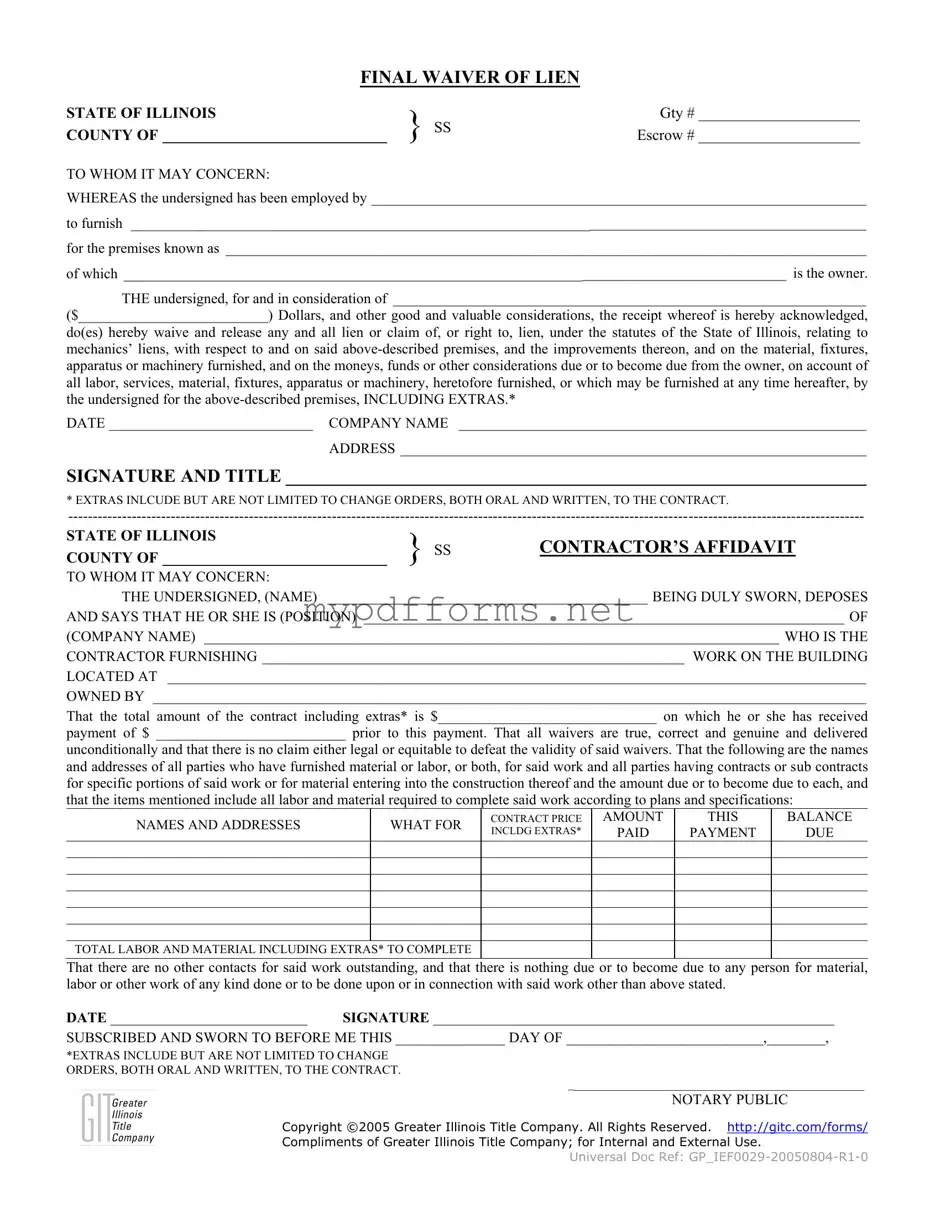The Illinois Final Waiver of Lien form shares similarities with the "Partial Waiver of Lien" document. Both forms serve to release claims against a property, but the Partial Waiver is specifically used when only a portion of the total payment has been received. This means that while the contractor or supplier waives their right to lien for the amount already paid, they retain the right to claim a lien for any remaining balance. Thus, the Partial Waiver provides a degree of assurance to property owners while still protecting the interests of contractors who have not yet been fully compensated.
Another document akin to the Illinois Final Waiver of Lien is the "Mechanics' Lien." This legal claim is filed by contractors or suppliers who have not been paid for services or materials provided. Unlike the Final Waiver, which relinquishes the right to file a lien upon receipt of payment, the Mechanics' Lien establishes the contractor's right to seek payment through legal means. The two documents are interconnected; the Final Waiver effectively nullifies the need for a Mechanics' Lien when payment is made, ensuring that all parties are clear about the financial obligations and rights associated with the property.
The "Contractor's Affidavit" is another related document. This affidavit is a sworn statement made by the contractor, confirming that they have received payment and detailing any outstanding debts related to the project. While the Illinois Final Waiver of Lien focuses on the release of lien rights, the Contractor's Affidavit provides a comprehensive overview of the financial status of the project, including amounts owed to subcontractors and suppliers. This transparency helps to prevent disputes over payments and ensures that all parties are informed of their financial standing.
The Illinois Employee Handbook form is a crucial guide for understanding workplace expectations and responsibilities, ensuring that both employers and employees are on the same page. By familiarizing yourself with the policies and procedures outlined, you can help mitigate misunderstandings and foster a positive work environment. To access this essential resource, you can visit Illinois Forms and complete the necessary documentation.
Similar to the Illinois Final Waiver of Lien is the "Subcontractor's Lien Waiver." This document is specifically designed for subcontractors who have provided labor or materials to a project. By signing a Subcontractor's Lien Waiver, the subcontractor relinquishes their right to file a lien against the property for the amount they have been paid. This waiver is crucial in maintaining trust between contractors and subcontractors, as it assures the primary contractor that they will not face additional claims from their subcontractors for the work completed.
The "Release of Lien" document also bears resemblance to the Illinois Final Waiver of Lien. A Release of Lien is typically used when a lien has already been filed, and the contractor or supplier wishes to withdraw that claim upon receiving payment. While the Final Waiver is proactive, the Release of Lien is reactive, addressing a situation where a lien has already been established. Both documents serve the purpose of clarifying the financial obligations and rights of the parties involved, ensuring that property owners are not burdened by unresolved claims.
The "Notice of Intent to Lien" is another document that shares characteristics with the Illinois Final Waiver of Lien. This notice is typically sent before a lien is filed, informing the property owner of the contractor's intention to file a lien due to non-payment. While the Final Waiver signifies that payment has been received and all claims are released, the Notice of Intent serves as a warning, prompting the property owner to settle any outstanding debts to avoid legal action. Both documents play critical roles in the mechanics' lien process, emphasizing the importance of communication and timely payments.
The "Lien Release for Payment" is yet another document that parallels the Illinois Final Waiver of Lien. This form is used when a contractor or supplier has been paid for their services and wishes to formally acknowledge that payment. Similar to the Final Waiver, the Lien Release for Payment ensures that the contractor cannot later file a lien for the amount received. By providing this release, contractors protect the property owner from future claims related to the payment made, fostering a smoother transaction process.
Finally, the "Final Payment Affidavit" is comparable to the Illinois Final Waiver of Lien. This document is a sworn statement confirming that the contractor has received final payment and that all subcontractors and suppliers have been paid as well. While the Final Waiver focuses on relinquishing lien rights, the Final Payment Affidavit emphasizes the completion of financial obligations. Together, these documents provide a comprehensive understanding of the financial landscape surrounding a construction project, ensuring all parties are aware of their rights and responsibilities.
